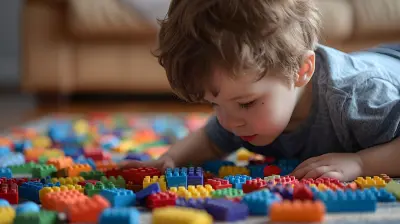Can Attachment Styles Change Over Time?
6 March 2025
Attachment styles play a crucial role in shaping how we connect with others in our relationships. You might have heard of terms like secure, anxious, or avoidant attachment, but there’s a lingering question that many people, including myself, often ponder: Can attachment styles change over time? Or are we stuck with the same attachment style for life?
The short answer is: yes, attachment styles can change. But it’s not always as simple as flipping a switch. It takes time, self-awareness, and sometimes even professional help to shift how we bond with others. But before we dive into the "how" and "why" of attachment style changes, let’s first break down what we mean by attachment styles and where they come from.

What Are Attachment Styles?
Attachment styles are essentially the patterns in which we relate to others, especially in close relationships. Think of them as the roadmap your brain uses to navigate emotional connections. These styles are rooted in early childhood experiences, particularly in how you connected with your primary caregivers.The concept comes from attachment theory, which was first introduced by British psychologist John Bowlby. According to him, the way we bond with our caregivers as infants shapes how we approach relationships as adults. Later, psychologist Mary Ainsworth expanded on this theory, identifying four main attachment styles:
1. Secure Attachment: People with this style feel comfortable with intimacy and are generally warm and loving. They trust others and themselves, leading to healthier relationships.
2. Anxious Attachment: Those with an anxious attachment style crave closeness but often fear abandonment. They tend to be needy, constantly seeking reassurance.
3. Avoidant Attachment: Individuals with this style are uncomfortable with emotional closeness and tend to avoid intimacy or vulnerability, sometimes appearing distant or aloof.
4. Disorganized Attachment: This style is a mix of anxious and avoidant tendencies, often stemming from trauma. These individuals may have a deep fear of rejection but struggle to trust or connect with others.
But just because you may identify with one of these styles today doesn't mean you're locked into it forever. So, how can attachment styles change over time?

Can Attachment Styles Change?
Here’s where things get interesting. While attachment styles are largely formed in childhood, they’re not set in stone. Our experiences as adults—especially in relationships—can significantly influence and change our attachment styles.Let’s break it down into the different ways attachment styles can evolve:
1. Through Healthy Relationships
Have you ever been with someone who just made you feel safe, secure, and understood? That’s not a coincidence. Being in a healthy, secure relationship can help modify your attachment style over time. For instance, if you have an anxious attachment style, having a partner who is consistent, reliable, and emotionally available can slowly reduce your anxiety.On the flip side, if you’re someone with an avoidant attachment style, being with a partner who encourages open communication and emotional closeness can help you feel more comfortable with intimacy.
In essence, relationships act as mirrors. They reflect our attachment issues back to us, but they also provide an opportunity for growth and healing.
2. Through Therapy and Self-Reflection
Let’s face it, some of us have deeper emotional wounds that can't just "heal" through a romantic relationship. Sometimes, we need a little extra help to change our attachment style—and that’s where therapy comes in.Therapies like Cognitive Behavioral Therapy (CBT), Emotionally Focused Therapy (EFT), and Attachment-Based Therapy can help you identify your attachment style and work through the underlying issues that perpetuate it. A therapist serves as a neutral party, guiding you to understand your emotional patterns and helping you develop healthier ways of relating to others.
Additionally, self-reflection and mindfulness can play a significant role in altering your attachment style. Journaling, meditation, and even just becoming aware of how you react in relationships can help you make conscious choices to shift your behavior.
3. Through Life Experiences
Life has a funny way of throwing curveballs, and sometimes, those experiences can change the way we attach to others. Traumatic experiences, in particular, can have a profound effect on your attachment style. For example, a person with a secure attachment style may develop an avoidant or anxious attachment after going through a painful breakup, betrayal, or loss.On the flip side, positive life events—like personal growth, career success, or a fulfilling relationship—can help solidify a more secure attachment style.
In a way, life experiences are like emotional weather. Sometimes it’s sunny, and you feel secure and grounded, but other times a storm can roll in and shake your foundation. The key is learning how to weather the storm and come out stronger on the other side.

How Do You Know If Your Attachment Style Has Changed?
You might be wondering, how do I know if my attachment style has changed? Well, the signs can be subtle but meaningful. Here are a few clues that your attachment style may be evolving:1. You Feel More Comfortable With Vulnerability
If you’ve always been avoidant but now find yourself more open to sharing your feelings and being emotionally intimate, that’s a sign of progress.2. You’re Less Reactive
Someone with an anxious attachment style may typically overreact to perceived threats of abandonment. But if you notice that you’re more grounded and less likely to spiral into anxiety, you may be shifting toward a secure attachment style.3. You Choose Healthier Partners
Another clue that your attachment style is changing is if you start gravitating toward healthier, more secure partners. People with anxious or avoidant attachment styles often fall into toxic relationship patterns. But as your attachment style evolves, you’re likely to seek out partners who respect your boundaries and provide emotional support.4. You Trust More
Trust is a hallmark of secure attachment. If you find yourself trusting others more easily and feeling less anxious about their intentions, that’s a strong indicator that your attachment style is becoming more secure.
Can Attachment Styles Revert?
Here’s the kicker: attachment styles aren’t always a one-way street. Just as they can change for the better, they can also revert back to less healthy patterns under stress or trauma.For instance, someone who has worked hard to cultivate a secure attachment style might regress to an anxious or avoidant style after going through a tough breakup or losing a loved one. The good news is that, with self-awareness and support, you can regain a secure footing.
Think of attachment styles like muscles. If you don’t work on them, they can weaken over time. But the more you flex those emotional muscles—whether through therapy, healthy relationships, or self-work—the stronger they become.
Why Does It Matter If Attachment Styles Change?
You might be thinking, Does it really matter if my attachment style changes? Absolutely. Your attachment style affects every single close relationship you have—whether it’s with your partner, family, or even friends. It influences how you communicate, handle conflict, and express love and affection.A secure attachment style is associated with healthier, more fulfilling relationships. But beyond that, it’s also linked to greater emotional well-being. People with secure attachment styles tend to have lower levels of anxiety and depression, and they generally experience higher life satisfaction.
So yes, it matters. And the best part is, you have the power to change it.
Final Thoughts
Attachment styles aren’t destiny. While they’re often formed in childhood, they’re not set in stone. Through healthy relationships, therapy, and personal growth, it’s entirely possible to shift toward a more secure attachment style.If you find yourself stuck in patterns of anxious or avoidant behavior, don’t lose hope. Change is possible, but it requires effort, self-awareness, and a willingness to grow. Think of it like learning a new emotional language—it takes time, but it’s completely achievable.
So, can attachment styles change over time? Absolutely. And the more we understand about ourselves and our relationships, the more capable we become of forging healthier, more secure connections with others.
all images in this post were generated using AI tools
Category:
Attachment TheoryAuthor:

Paulina Sanders
Discussion
rate this article
7 comments
Kenneth Hodge
Thank you for this insightful article on attachment styles! It’s fascinating to consider how our experiences can influence our relationships over time. Understanding these changes offers hope for personal growth and healthier connections. I look forward to exploring this topic further!
April 3, 2025 at 3:29 PM

Paulina Sanders
Thank you for your thoughtful comment! I'm glad you found the article insightful and are eager to explore attachment styles further. Personal growth in relationships is indeed a fascinating journey!
Zephyrine Navarro
Fascinating topic! How do life experiences shift attachment styles?
March 25, 2025 at 5:43 AM

Paulina Sanders
Life experiences, such as relationships, trauma, and personal growth, can significantly influence and reshape attachment styles over time by altering how we perceive and interact with others.
Carly Green
Absolutely, attachment styles can evolve as we gain new experiences and insights. Personal growth, therapy, and significant relationships can all play pivotal roles in reshaping how we connect with others. Embracing this possibility empowers individuals to foster healthier relationships and enhance their emotional well-being. Change is not only possible; it's often essential.
March 24, 2025 at 3:34 PM

Paulina Sanders
Thank you for your thoughtful comment! I completely agree—personal growth and key experiences can profoundly reshape our attachment styles, leading to healthier connections and improved emotional well-being.
Solaria Hardy
What a fascinating read! It's so encouraging to see how attachment styles can evolve throughout our lives. It highlights the power of self-awareness and growth in our relationships. I love the idea that we can actively shape our connections and foster healthier bonds. Thanks for sharing these insights!
March 18, 2025 at 4:49 PM

Paulina Sanders
Thank you for your thoughtful comment! I'm glad you found the insights on attachment styles and personal growth encouraging. We can indeed shape our relationships positively!
Dorothy Potter
This article provides valuable insights into the dynamic nature of attachment styles. It highlights how experiences, relationships, and personal growth can influence attachment, suggesting that change is possible. Understanding these shifts can enhance self-awareness and improve interpersonal relationships, making it essential for personal development.
March 16, 2025 at 5:44 PM

Paulina Sanders
Thank you for your thoughtful comment! I'm glad you found the insights on attachment styles and personal growth valuable. Recognizing the potential for change is indeed key to enhancing relationships and self-awareness.
Alanna Valentine
Sure, attachment styles can change—just like my opinions on pineapple on pizza. #Growth
March 10, 2025 at 3:25 PM

Paulina Sanders
Absolutely! Growth and self-awareness can lead to shifts in both attachment styles and personal preferences.
Arianth Romero
This article offers a compelling exploration of how attachment styles can evolve throughout life. It highlights the impact of experiences and relationships on our emotional bonds, emphasizing that personal growth and self-awareness can facilitate positive changes. Understanding this fluidity can empower individuals to foster healthier connections. Great read!
March 6, 2025 at 4:29 PM

Paulina Sanders
Thank you for your thoughtful comment! I'm glad you found the exploration of attachment styles and their evolution insightful. Empowering individuals to understand and improve their connections is indeed a key takeaway.
MORE POSTS

The Role of Emotional Intelligence in Mental Health

How to Foster Independence in Autistic Children

Managing Perfectionism: Letting Go of Unrealistic Expectations

Personality Disorders and Intimacy: Challenges and Strategies

How to Manage Relationship Stress for Better Mental Health

Supporting Autistic Teens Through Social Challenges